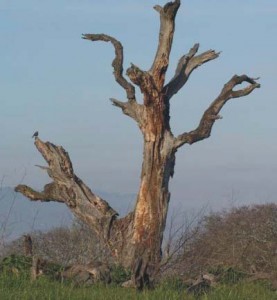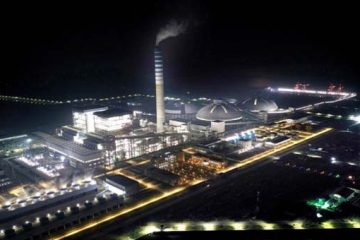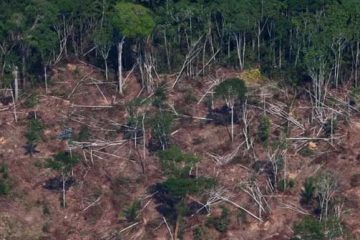From The Daily Star
Morticulture
Towards a new paradigm for conserving biodiversity
Dr. Md. Mizanur Rahman
 IT was not a poet but an American scientist, Mark Harmon, who nicknamed his field of study “morticulture”, to suggest the importance of managing the dead trees in the forest to maintain biodiversity. Deadwood plays a vital role for the functioning of forest ecosystems. Deadwood is an indicator that captures many elements of naturalness and is becoming a general reference for natural forests. Deadwood has become an important indicator to determine ‘hemeroby’ (the degree of naturalness) of forest ecosystems. It can be found as standing and downed dead trees. Standing deadwood is termed as snag and lying, as log.
IT was not a poet but an American scientist, Mark Harmon, who nicknamed his field of study “morticulture”, to suggest the importance of managing the dead trees in the forest to maintain biodiversity. Deadwood plays a vital role for the functioning of forest ecosystems. Deadwood is an indicator that captures many elements of naturalness and is becoming a general reference for natural forests. Deadwood has become an important indicator to determine ‘hemeroby’ (the degree of naturalness) of forest ecosystems. It can be found as standing and downed dead trees. Standing deadwood is termed as snag and lying, as log.
“Some people think dead and dying trees look nasty or they are afraid they will fall on their house so they take down the whole tree,” says Kathy McNeil, a naturalist at Huntley Meadows Park in Alexandria, Virginia. “But snags are rich in fungal life and beetle larvae channels.” Both snag and log have significant impact on several ecosystem processes, including habitat for small animals, seedbeds for plant establishment, and storage of carbon. Approximately a fifth of the plants and animals found in the forest, that is to say over 6000 species, are dependant on deadwood as a place to live and as a source of food (Xylobionts). They provide nesting, roosting, feeding, loafing, and storage sites for birds, small mammals, reptiles, and amphibians. Deadwood reduces soil erosion and affects soil development, stores nutrients and water, and is a major habitat for decomposers and heterotrophic organisms.
Different sizes of snags encompass the needs of a broad suite of different bird species: small tree (e.g., chickadees, downy woodpecker, asian hairy bluebirds etc.), medium tree (e.g., eurasian kestrel, magpie robin, hairy woodpecker, red-breasted nuthatch), and large tree (e.g., different types of woodpecker and owl). Generally small standing deadwood is considered to be of some value for foraging birds and small cavity nesters.
Several species of birds, including woodpeckers act as primary cavity excavators, meaning that they excavate holes, or cavities, in snags both when looking for food and to build homes. Without snags, these birds could not live in forests. Some birds as well as most cavity dependent mammals are secondary cavity users, meaning that they depend on primary excavators and/ or natural decay of trees to form cavities that they can use for nesting. Cavity-dependent bird species comprise 20-40% of the birds in a given forest anywhere of the world. Snags serve as important habitats for the insectivorous birds.
There is strong relationship between forest-floor vertebrate occurrence and deadwood volume. Certainly salamanders, small mammals, and ruffed grouse use deadwood in the forest. There are many other living creatures that benefit from snags for a variety of reasons. Raptors use snags as perches, bats often roost under bark flakes, and small mammals may use excavated cavities for feeding, foraging, and protection from thermal drought. Snags also provide some cover and, thus protection, from predators for small mammals. The availability of standing deadwood influences the population size of cavity breeding animals. Small mammals depend on log for feeding and foraging sites as well as for protection from predators. Amphibians such as toads and frogs rely on logs to protect them from thermal drought (i.e. drying out of their skin), predators, and to provide them foraging sites. Moreover, these species depend on logs in streams and lakes for breeding and feeding habitats as well.
Deadwood not only provides critical habitat for animal species, but it also is a preferred growing medium for various species of bryophytes, lichens, and fungi. Fungi and bryophytes have their highest diversity on logs. Natural dynamics of logs is very much essential for the abundance of fungi. Mushroom has the highest diversity on logs of intermediate decay phase. Different edible ferns like both intermediate and late decay stages. Rotting wood on the forest floor can also provide good seedbeds. Logs supply moisture and nutrients, which encourages good seedling growth, which, in turn, promotes the natural succession of these species in the forest. Without this deadwood many animal species will be without homes and/ or sources of food, which could eventually result in these species becoming locally extinct.
Forest management has come a long way in terms of its treatment of deadwood. There is recognition that the removal of all deadwoods following harvesting can be extremely harmful to the forest ecosystem. The increased awareness of the importance of deadwood as critical habitat coupled with the ever increasing importance put on mimicking natural disturbance patterns in forest management across the world have resulted in an augmented desire to manage deadwood in reserve forests.
From a wildlife habitat point of view, it has commonly been assumed that some deadwood is better than none and that more is better than some. The size of a snag is of utmost importance, as larger animals are not able to utilize snags that are too small in diameter and/or height. Attempts should be made to maintain larger dead trees when harvesting. Snags will be utilized by certain species whether or not they occur as single stems or clumps of snags over the landscape. Single stems may help ease competition between species because they provide a wider range of potential habitat. However, clumps of snags scattered throughout the harvested landscape can be quite beneficial for snag users as well. Clumps of snags can help make foraging more efficient and can provide protection from predators for animals roaming on the ground.
Small mammals, as well as fungus, bryophytes, mosses, and lichens, all benefit from a variety of sizes of downed woody debris. From a management point of view, this means leaving branches and twigs, as well as some larger pieces of wood (i.e. small stems or bits of stems that are damaged). The importance of both fine and coarse woody debris should not be overlooked and efforts should be made to leave quantities of both on site after harvesting. Perhaps, more amenable to both tree species and wildlife is to spread logs evenly in lines (if exposed mineral soil is necessary for seedlings) in between planting rows over the entire landscape. This has the added benefit of providing a continuous travel route for wildlife using logs as Subnivean habitat and/or as protection corridors from predators. It is obvious to keep the right balance of snags and logs to conserve the forest biodiversity.
The presence of deadwood in the forests of Bangladesh is a very rare case. Due to the scarcity of fuelwood, local people cut trees immediately after their death. The writer found only 11 snags in the core area of Madhupur National Park, which was very poor a number compared to the dead wood level of natural tropical forests in India. Actually, there is no reference level of deadwood for sub-continental tropical forests. The amount of dead wood in natural forests can be very extensive: up to 30% of dead stems, 25% of aboveground biomass or about 40% of the volume of living trees in European temperate forests. The amount of dead timber retained within managed forests is open to debate and management decisions will require detailed knowledge of local conditions. A general rule will probably be the more the better, although the quantity will be a trade off against the value of timber and the practical inconvenience of large amounts of deadwood in production forests.
For the forests of Bangladesh 5% of total volume of wood could be suggested as a reasonable amount, divided between snags and logs .Lacking of deadwood is one of the major causes of the disappearing, or red-listing of most of the birds, mammals, reptiles, and amphibians in our forests. The white-backed woodpecker is one of several specialised forest species whose population has declined. It is considered as an indicator, or umbrella, or keystone species in different parts of the World. Considering its indicator value, its specialised habitat requirements and its potential as a communication tool, using the white-backed woodpecker as an umbrella species provides a coarse filter for the conservation of several other animal species of the deciduous forests.
As a keystone species, it substantially alters the physical structure of the environment, influencing both available habitat for other species and various ecosystem processes. The effects of its conservation for many other species and various ecological processes are both wide and unique. For conserving woodpeckers it is obvious to conserve the deadwood in the protected areas of our country. Deadwood is increasingly being accepted as a key indicator of naturalness in forest ecosystems all over the world.
An integrated strategy may be adopted to conserve the deadwood in the protected areas, which should include: a) quantifying the extent of the challenge, b) identifying and protecting key sites, c) providing effective guidance within protected areas, d) legislative needs , e) educating users, f) enforcing controls, g) using surrogates, h) public awareness, i) developing guidelines for deadwood monitoring and management including minimum thresholds for deadwood as an indicator for biodiversity and naturalness, j) using active restoration measures, k) including deadwood in national biodiversity strategies and national forest programme, l) stopping removal of old trees and deadwood from the protected areas, and m) supporting and collaborating on key research projects aimed at quantifying the biodiversity values of deadwood.
At the World Summit on Sustainable Development held in Johannesburg in 2002, the international community committed itself to protect and restore the integrity of our planet’s ecological systems. Reaffirming the goals and objectives already laid down in the Rio Declaration on Environment and Development and the Agenda 21, including the Convention on Biological Diversity, the community considered measures to reduce the rate of biodiversity loss at national and global levels as a high priority. Different measures have been proposed to this end, including the creation of plantation species mosaics, embedding monocultures in a matrix of intact or restored vegetation, using indigenous species rather than exotic species, or preserving micro-habitats such as dead wood that are known to be particularly species-rich. Now it is the time to update the policy in favour of deadwood to meet the obligations under the Convention on Biological Diversity.
The writer, a biodiversity specialist, is Assistant Commissioner, DC Office, JhalakathiE-mail: mailto:mizan_peroj @yahoo.com
Courtesy of The Daily Star





